
|
||
|
Portland art blog + news + exhibition reviews + galleries + contemporary northwest art
|
||
A Seat At The Table? Considering Soft Power: MK Guth and Mark Smith "Only through art can we emerge from ourselves and know what another person sees" -Marcel Proust
Proust is utterly wrong with that quote of course, but it is a sentiment of yearning and perhaps a tad religious one at that. Instead, Art tends to be as subjective as anything else... though visiting someone's home or having a meal together is a kind of shared experience that is similar to looking at art or a performance together. In fact, all meals are performances and there is a power in such communion. The point being that art doesn't have any special authority, only that it has license to make unexpected demands on those that experience it. Sometime between the time of Lascaux and Titian though, art experiences became increasingly elitist and about projecting power. This was the hard power of class authority or social station. Georges de La Tour, Porridge Eaters (1625) In the 1600's a painter by the name of Georges de La Tour broke from the traditional baroque painting subjects like academic history scenes (history through the lens of those in power) and patron portraits to focus on genre scenes of commoners at work and play. Rather than using the image to project authority or hard power in an icon it projected a pervasive or soft power of secular domestic life and simple everyday pursuits. A few hundred years later when Manet exhibited Olympia it shattered the secrets of the oldest and basest of professions. It wasn't until Warhol that celebrity power in art regained some of its iconographic elan that was once absolute. Yet, Warhol treated his subjects like raw material ultimately making the glamorous into banal pop fodder. In many ways Warhol was a leveler and that's why his cookie jar collection etc. became more than just a banal yard sale... it had accrued a kind of soft power because it was so relatable. The objects themselves were not astonishing. 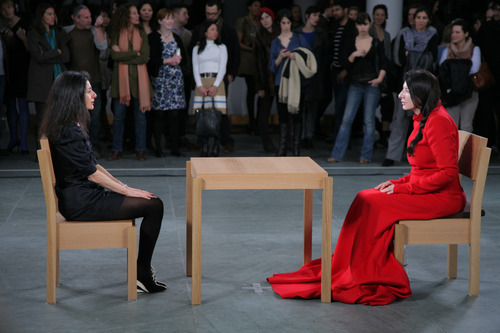 Marina Abromovic, The Artist is Present (MOMA 2010) Similarly, ever since Judd's essay Specific Objects essay in 1965 the object itself (discrete artifact of veneration) has held less influence, instead emphasizing the way a work object operates in space. But a funny thing has happened since the object became secondary to experience... these very common genre scenes have been re-iconified as performance using objects or places as a prop. For example, artists like Gordon Matta Clark with his Food project, Vito Acconi's Where Are We Now (Who Are We Anyway) and most recently Marin Abromovic's The Artist is Present at MoMA all deal in something I like to call Soft Power. It is a a kind of banal open relatability (tables and other furniture are very popular in the genre). Perhaps the most interesting example of this was Franz West's Passtuck works because the artist invited the viewer to engage with his objects ergonomically. 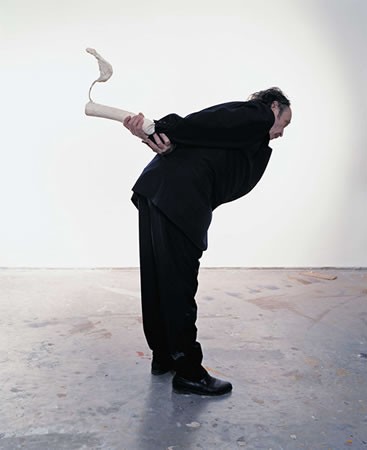 Franz West holding one of his Passtucks Essentially soft power reveals human connections and common genre moments to give the participants both Warhol's 15 minutes of fame and a personal icon that is relatable. This is art that wants attention on the personal level. That kind of attention is perfect for the Me generation of social media where likes and shares are the only currency. 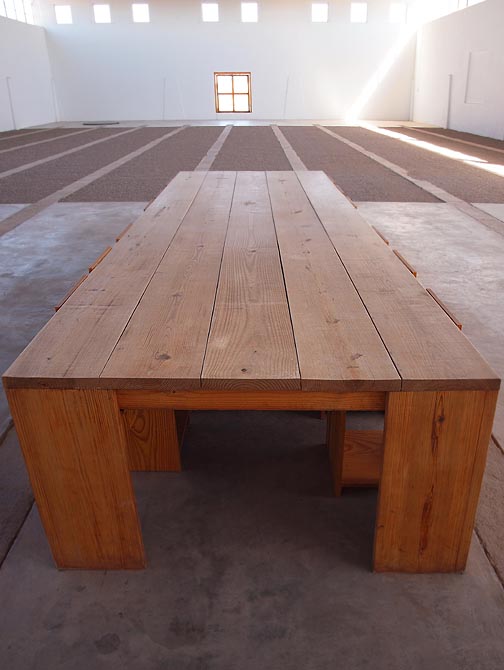 Judd table at Chinati Foundation (photo Jeff Jahn) The thing is soft power (creating totemic tokens of an event or encounter) produces art pieces that are artifacts of an event therefore very different from Judd who separated his art from his furniture quite distinctly. (Judd held plenty of dinners at his trademark tables and all successful artists must be masters of soft power hence the reason his furniture isnt art but it isn't quite JUST furniture either). Still, the two anti-object approaches are just sibling rivals which tacitly critique one another. Anti artifact art seeks to avoid pandering to the viewer and encounter artifact work seeks to avoid being aloof or unrelatable. Artists like Storm Tharp and Jessica Jackson Hutchins have also created domestic situations in a way that positions Portland work as very interested in soft power. 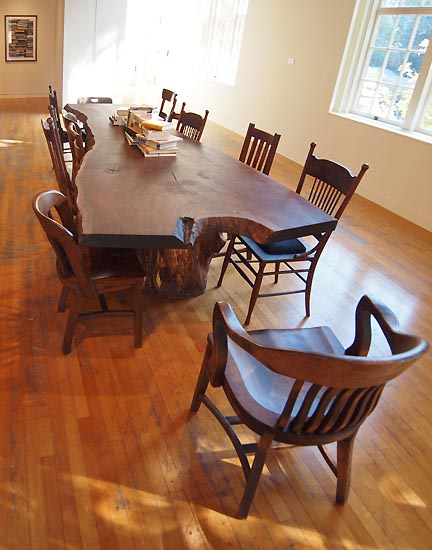 MK Guth's Table for Twelve at the Art Gym (2012) photo Jeff Jahn Which brings me to two current shows by veteran Portland artists, Mark Smith and MK Guth. Mark Smith's exhibition, Vestibules and Portraits, Laminates and Veneers at Elizabeth Leach Gallery purposefully inverts the whole iconographic process by using the domestic soft power materials as a veneer to a warholian iconographic effect that is personalized, not some top down idol. Visually it also has its roots in populist hippie era psychedelia, which was also trying to generate shared group experiences. 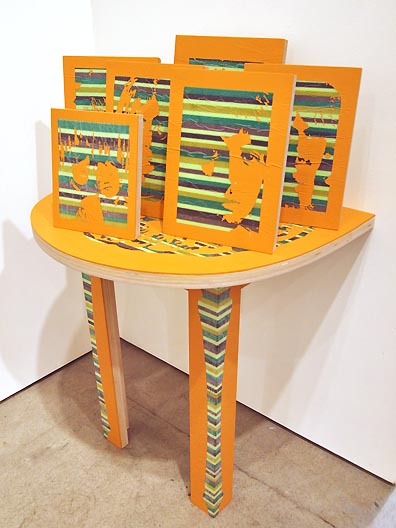 Mark Smith, End Table with The Beatles, Alyson and Leslie and the Reverend Sun Yon Moon (2012) In particular Smith's End Table with The Beatles, Alyson and Leslie and the Reverend Sun Yon Moon takes pop icons, a religious leader and two people most people do not know is served up as a kind of soft power altar. It isnt that different from pinterest where users can arrange their visual interests in albums. The difference here is that Smith formally unifies them via soft blanket materials (a Greenbergian and hippie era formal trick) to make them both stranger and more approachable. These soft elements feel like a object commentary on social medium, which employs similar veneers to make the internet seem warmer fuzzier and more relatable. 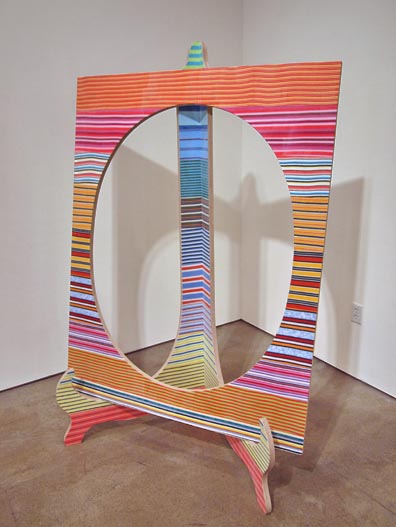 Mark Smith Open Cameo By turning the entire gallery into a table or shelf Smith's Open Cameo with a stand does the same thing only by making the normally tiny frame and stand human sized and devoid of faces (replaced with a void) it invites a kind of interaction (though its placement in the corner somewhat squelches it). Many artists use soft materials these days to evoke a domestic parlance but Smith has been doing quite a long time exhibiting stadium plans vacuum packed with lost and found clothing over a decade ago in the 2001 Oregon Biennial. Somehow, now that the domestic and soft power is en vogue Smiths veneers have become bolder and more compelling, particularly in the sculptural works. In the past traditional sculpture was relegated to heavy materials like granite, marble, various metals or wood but in these cases the soft veneer itself supersedes the supporting wood... cuing the viewer that it is their own personal relationship to this soft material that is most important. 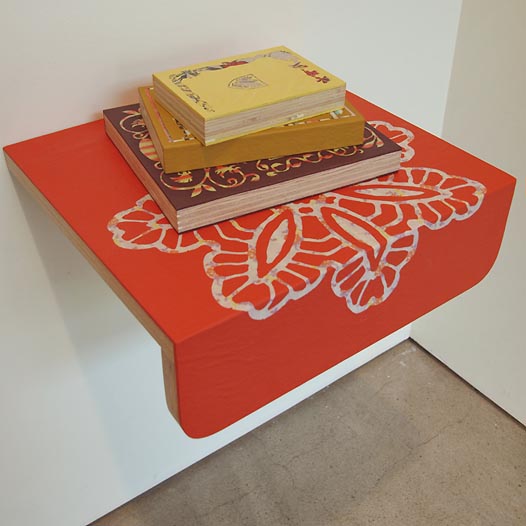 Mark Smith, Book Stack (top to bottom) German Grammar, Family Sunday and Betty Crocker (2012) Mark Smith, Book Stack (top to bottom) German Grammar, Family Sunday and Betty Crocker (2012)
Smith's Book Stack (slyly recalling Judd's stacks) also wears its heart on its sleeve... taking book covers (an autocratic visual form if there ever was one) and handicrafts them into folk objects or heirlooms... which is a quite a reversal for the nostalgic Betty Crocker cookbook or German Grammar. Somehow it feels personal but in fact it is an engineered soft power experience. Similarly, at the Art Gym MK Guth uses the overlay or veneer of shared experiences (and a lot of gnarled knotty and highly figured wood) to create a somewhat less poppy but still rather folksy experience. Her shelves also recall Judd's stacks. The Proustian title for the show, "when nothing else subsists, smell and taste remain" definitively places the objects themselves in the service of soft power concerns like gathering people together. 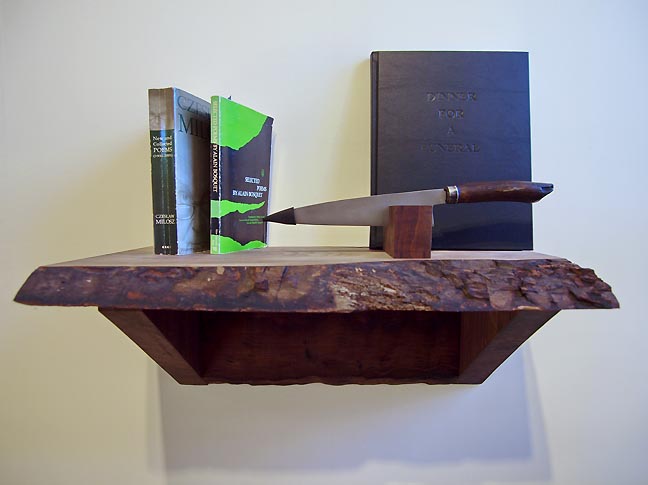 MK Guth, Dinner for a Funeral (2012) Like any dinner party Guth creates socially engineered situations around tables or shelves that like Clark or Abromovic that coalesce around her often wood centric objects. Her Dinner for a Funereal with its handbook-like black embossed book cover, other books and black baited kitchen knife is perhaps the only terribly edgy thing here but that is the point (bad pun). The point being, real life dramas can beat any fiction. Likewise situations like Dinner for Women or Curators seem to recreate scenarios that take place all of the time. Curators have lunch with one another to compare notes and coordinate... and sometimes the ladies find it novel to dis-invite the boys. Often these informal soft power moments set important and lasting wheels in motion. Is Guth trying to claim the dinner party? Well Portland is a food driven place and we sure do like wood. 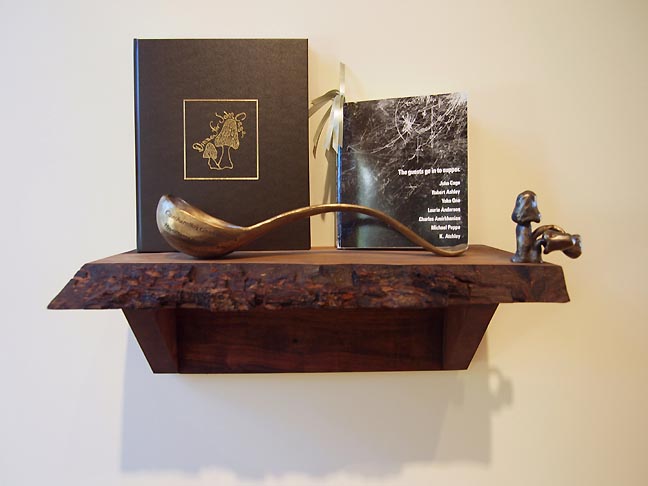 MK Guth, Dinner For John Cage (2012) Photo Jeff Jahn Pieces like Dinner for John Cage and Dinner for Women seem like can't miss happenings. Besides, who can hate John Cage or Women and expect to be invited to any dinner party? 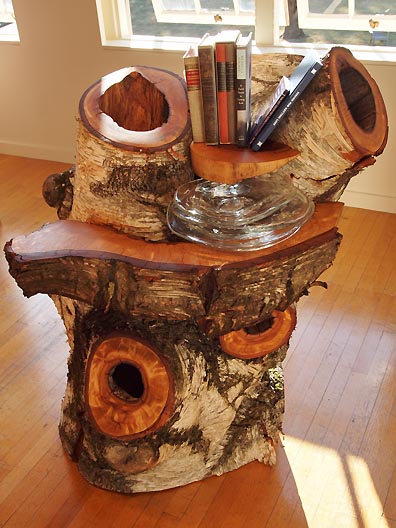 MK Guth, Dinner for Getting Lost (2012) Photo Jeff Jahn My personal favorite is Dinner for Getting Lost. The stump looks like something from Guth's yard and I can just picture the eventual location for the meal being in some roadless area where the guests are only given a vague map and a machete but only after being blindfolded and driven to an undisclosed wilderness. Directions like, "turn right at the second badger and 30 degrees left at the fourth red squirrel," would ensure that the companion piece Dinner for a Search Party would have to be made. 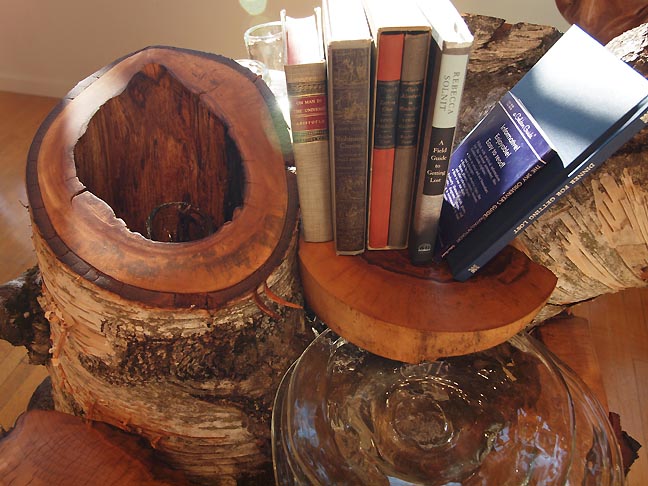 MK Guth, Dinner for Getting Lost (detail) The point being that this show deals in suppositions as much as supper. Those who don't get to be part of the Dinner for Curators or Dinner for Crying might feel excluded because there is a supposition that what transpired was important. In fact that is hardly ever the case, instead it is the familiarity and bonds of trust one develops through the shared experience and proximity which become the true soft power component that almost all human interaction/empathy traffics in. These interactions become the foundation of relationships that then might lead to something important. In fact all meals are performances and the allusions to Marcel Proust in Guth's show are just a way of giving the meal as a palimpsest an intellectual context. Still, I feel the fact that everyone has to eat trumps Proust's influence. In many ways Guth's exhibition is an exercise in relational aesthetics for the Northwest crowd.... a people who love food, close clustered groups and wood. I hope people see the kitsch in this choice because Guth clearly did with her campy mushrooms and plates made out of wood... treating the whole affair as if the Northwest was just one big Black Forrest Cuckoo Clock. It is a sly move since making everything out of huge slabs of Douglas fir would have been more typically Cascadian? Guth's objects themselves are just totemic props, a little like ceremonial potlatch feast accoutrements. Smith's are a little more icon driven but both artists felt a burning need to make book shelves, which is about the most Portland thing I can think of. One thing isn't open for debate though, both artists made use of shelves and domestic style tables. It is an effective ploy to usurp the standard display cases of museums, making the work more domestic and relatable. None of this channeling of power is new of course (Fritz Haeg plants gardens and Harrell Fletcher made other people's wishes come true) but it does represent the art world's increasing focus on reaching out to viewers. Even Mark Smith's work seems to present art as a normalizing force rather than acting as a fountain of exceptional and the odd. What does art gain from being so accommodating? ...well about as much as it gains from being exceptionally specific, the two are sides of the same experiential art coin. It is the final weekend for MK Guth's exhibition at the Art Gym. Mark Smith's exhibition runs till December 29th. Posted by Jeff Jahn on December 06, 2012 at 13:17 | Comments (0) Comments Post a comment Thanks for signing in, . Now you can comment. (sign out)
(If you haven't left a comment here before, you may need to be approved by
the site owner before your comment will appear. Until then, it won't appear
on the entry. Thanks for waiting.)
|
| s p o n s o r s |
 |
 |
 |
 |
 |
 |
 |
 |
 |
 |
 |
 |
 |
 |
 |
 |

|
Site Design: Jennifer Armbrust | • | Site Development: Philippe Blanc & Katherine Bovee | |

